Seventeen high-profile academics with expertise across the climate research spectrum, from atmospheric science, earth science and environmental science, to economics, global change and public health led by James Hansen, now at Columbia University’s Earth Institute, have published a paper Assessing “Dangerous Climate Change”: Required Reduction of Carbon Emissions to Protect Young People, Future Generations and Nature which demands attention.
The bottom line is that “aiming for the 2°C pathway would be foolhardy” because it “would have consequences that can be described as disastrous”. The authors believe that humanity and nature, the modern world as we know it, is adapted to the Holocene climate that has existed more than 10,000 years. Departing from this climate by more than 1°C would have intrinsically harmful effects. At 2°C these effects become unacceptably severe. Moreover we enter a zone where further feedbacks, such as ice sheet response, methane release and vegetation change, are likely to push the climate towards further warming, of probably at least 3°C.
James Hansen and Pushker Kharecha have done a summary with discussion here, then there’s Joe Romm at Climate Progress, Tim Radford at Climate Code Red, Damian Pattinson, Editorial Director, PLOS ONE and at Huff Post. My partial summary is below.
I won’t recount the arguments as to why we need to stick to 1°C here. Historically the notion of a 2°C guardrail was devised by the Germans back in the 1990s. David Spratt and Philip Sutton did an online piece entitled The big melt in 2007 in response to the dramatic melting of Arctic ice that year wherein they proposed a return to CO2 levels of 320 ppm in order to limit the temperature rise as close as possible to 1°C.
This material was incorporated into the book Climate Code Red which highlighted the notion of a safe climate.
At the same time Bill McKibben had asked James Hansen what the desirable limit of atmospheric CO2 should be. At the time 550ppm was common, with brave souls suggesting 450ppm. In December 2007 at the meeting of the American Geophysical Union Hansen gave his answer – 350 ppm in the first instance, for a safe climate. Little attention was paid to Hansen apart from McKibben who ran with 350 and has been running ever since.
Meanwhile the goal of 2°C was accepted internationally at the UNFCCC meeting at Copenhagen in December 2009. Bolivia made a brave attempt at 1.5°C the following year at Cancun but received no support.
Hansen has never deviated and now argues his case in more detail. The important question is, can 350 ppm and roughly 1°C be achieved. Hansen and Kharecha:
- human-made warming could be held to about 1°C (1.8°F) if cumulative industrial-era fossil fuel emissions are limited to 500 GtC (gigatons of carbon, where a gigaton is one billion metric tons) and if policies are pursued to restore 100 GtC into the biosphere, including the soil. This scenario leads to reduction of atmospheric CO2 to 350 ppm by 2100, as needed to restore Earth’s energy balance and approximately stabilize climate.
The current emissions rate for fossil fuels is about 10GtC per year. The authors calculate that cumulative emissions from 2013 to 2050 should not exceed 130GtC. This will require a 6% reduction each year, starting now.
If emissions continue to grow until 2020, as seems likely, emissions will need to reduce by 20% pa thereafter.
In addition, we will need to remove 100 GtC from the atmosphere and hold other greenhouse gases to net zero.
Removing 100 GtC from the atmosphere will only result in a net reduction of about 50 Gt. In simple terms atmospheric carbon is in dynamic balance with carbon sinks. Take CO2 out of the air and it will be partially replaced by CO2 outgassing from the ocean, for example.
Direct removal does not come cheap. The American Physical Union estimates a cost for air capture of 1GtC as about $2 trillion, so the total bill could be $200 trillion. I could be wrong but I make that $545 per tonne of CO2. The paper says that the cost of carbon is uncertain to a factor of 10 or more, but could be as high as $1000/tCO2.
I gather the authors think 100 GtC could be removed for less than that via reforestation and improved agricultural and forestry practices. The practicalities of direct capture are significant. One GtC turned into carbonate bricks would yield a pile equivalent to 3000 Empire State buildings or 1200 Great Pyramids of Giza.
Nevertheless it raises the question as to what atmospheric dumping fees should be imposed on carbon emitters.
Given the uncertainty over real costs and political realities, the paper recommends an initial carbon tax of $15/tCO2 with a rise of $10 each year to change behaviour. Border taxes for embedded carbon imports are suggested.
Of course, most fossil fuel reserves will need to be left in the ground. The paper charts the fork in the road in the energy system which began with the industrial era when coal increasingly took over from wood. The size of the task confronting us now is illustrated in this graph:
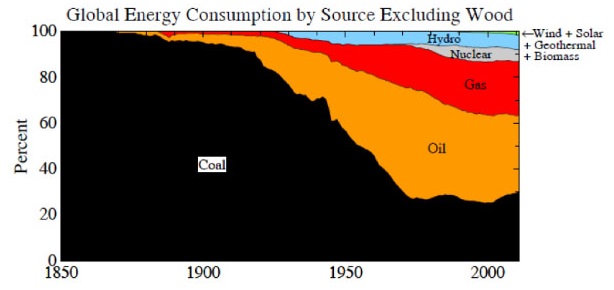
The paper sees a role for nuclear, which is elaborated in more detail in Hansen and Kharecha. They emphasise new generation technology.
The paper also has some interesting graphs as to who is doing the emitting currently and who has been most responsible in the past. First the current emitters:
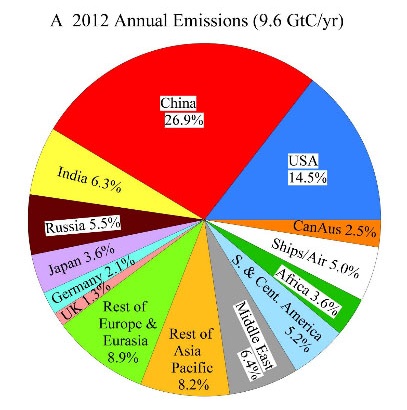
This is what that looks like on a per capita basis:
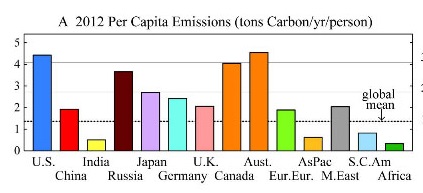
Here we have the cumulative emissions by country since the beginning of the industrial age:
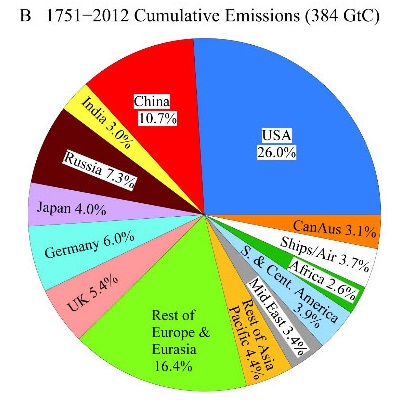
And cumulative emissions on a per capita basis:
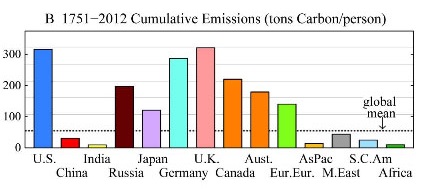
In this case China virtually disappears, yielding prominence to the likes of the UK, Germany and Canada.
This information will no doubt be taken into account during negotiations in what has been referred to as “common but differentiated responsibility”.
Conclusions
The big message out of this is that notions of a 2°C guardrail are dangerously wrong-headed. We need to be thinking 1°C if we want to pass on to future generations a safe climate.
Secondly, the time for concerted action to commence is now. Leaving it for a few years makes it harder, much harder.
Third, everyone in the world has to act. The matter is so finely balanced that there can be no free riders.

Disagree with the second conclusion.
The time to commence any preventative concerted action has passed – and that opportunity will never, ever return. Too late.
All we can do now is avoid annihilation – and only if we work very hard and become remarkably lucky.
Disagree with the third conclusion.
Never mind the rest of the world. We got further into this mess because everyone was waiting for concerted action from everybody else – concerted action will never happen.
Australia must take resolute action alone and now – and to blazes (literally) with what the rest of the world does or wants or intends.
That would mean taking leadership in a country where leadership is very rare indeed.
Listening right now to Philip Adams’ “Late Night Live” (ABC-RN) on the same topic. It’s podcast as well as being rebroadcast tomorrow afternoon at 4:05pm (Queensland funny time).
I just watched Stefan Molyneaux at http://www.freedomainradio.com who says a few things I can agree with,but maybe,I also cannot.I doubt wether Brian here could stomach it about matters Climate Change .I wonder ,however,if the recent new lowest temperature in Antartica is explainable by the ongoing attempts to claim the Climate is warming up.Well not easily graspable at least.Don’t stay awake for me!
The figures for each country are misleading because it measures emissions on the basis of where it is emitted, not where products that of those emissions are used. For example, Chinese emissions might look bad because the steel used to make cars for exports is produced in China. The emissions resulting from the manufacture of cars sold to Europe are not counted in the EU stats.
How goes it!? The Gaurdian. Newly discovered greenhouse gas 7000 times more powerful than CO2 Perfluorotributylamine.Gave me a electro shock….at molecular level 12/12/2013 .Sleep on it.A couple of questions could be asked.Could CO2 be used in the atmosphere to reduce the effect of this chemical substance,or its transient non captured feral variety modified by temperature matters on the gas as a industrial purpose!?
[O/T]
John D, were you the person who wrote the guest post on the Rudd government insulation scheme and how the death rate from workplace accidents (which was touted as being the Government’s fault, whereas it was 100% the fault of the employers, but of course neoliberal politicians can’t admit that) was actually lower than the average?
I remember it, but can’t find it.
I can find a post by Mark with a link to Possum Comitatus about the fire rate (also below average) but I do remember one about the workplace deaths.
If that was you, could you possibly find a link for me?
Sorry for derail
[O/T, although related to climate change policy]
I love it when everyman/woman and his dog feels sufficiently informed and scientifically literate to express an opinion on the science of the report. Here’s another way to read science, it involves several steps mostly checking the creds of the authors after which it involves the very simple act of merely, and humbly, listening to what they are saying which, in this case, is summarized neatly by:
Are you deliberately posting gibberish in order to get a rise, or is this a poe?
Bernard J, opinions on what on earth philip travers means by what he posts are divided. When he doesn’t breach the comments policy, we publish what he writes. ::shrug::
What tigtog said.
jungney @ 6, yes, I could have spent 1500 words summarising the first 12 pages of the article. By that time most would have been asleep!
Helen, if you search for ‘pink batts coronial inquest’ or similar you might find some stuff.
The best account I can find of what happened is by Tristan Edis.
Alan Austin mounts a vigorous defence. He also links to the coroner’s findings.
These articles perhaps highlight the criticism of governments. I think the Abbottistas are on the trail of the number of times Rudd was said to have been warned about safety concerns.
Thanks very much Brian, I’ll read your links today after dog walking and other Saturday activities!
Graham Bell said,
“Australia must take resolute action alone and now – and to blazes (literally) with what the rest of the world does or wants or intends.”
I don’t really see how this is possible without the total financial collapse of Australia. We have manufacturing/processing on its knees, agriculture is debt ridden with poor returns, and Australia is relying on the mining of coal amongst other things to prop up our economy along with the sale of the publics assets, road rail, power generation, water, land; whatever the governments want to sell.
If you add this to the invalidity of the western world corporate governments and the loss of our sovereignty, I’d say Australia has passed its peak, the future isn’t going to be pretty, whether that is higher temperatures, financial collapse or war. It’s not just GMH that encountered a perfect storm, its the whole country. Australia is living on borrowed time, just the same as the car industry was, and I agree our governments have been and are the biggest part of our problem. Unfortunately Australian’s as a whole can’t just pack up and move to another country for a better deal, like GMH can. The blame I’m afraid collectively rests with all of us, and the solutions are also ours to initiate.
This comment are my views, and I won’t have the time to argue with anyone here.
Helen: I can’t remember writing a guest post on pink batts but have referred to the possum stats and a Colbatch article based on the possum stats in the SMH.
I also remember pointing out somewhere that the number of deaths was statistically too small to reach any conclusions even if there were no deaths before the big campaign. More frequent events (like the fires) are a better guide to relative safety performance.
The possum stats say it all. You wonder how Abbott’s commission is going to help the country.
Helen, I wrote two posts on the scheme: one on employee death rates and one on fires. If there is a royal commission on this, maybe I should make a formal submission ….
(I think my posts have links to possums posts too).
John Michelmore @ 12:
I do appreciate your concern and your pessimism. The situation is very bad but not hopeless. The Recovery will be difficult but not impossible …. and it can be done without sacrificing democracy …. but it will take a lot of radical changes and it will take chucking sectional interests off their gravy train.
Take HOUSING for instance: Put all building regulations and “standards(??)” up to rigorous scrutiny – and abolish immediately all those that exist solely for the purpose of separating suckers from their money.
Whack a 50% Luxury Tax on all new bludgertoriums and give real incentives for dividing the existing ones into duplexes or even several flats. Building and maintaining these monstrosities wastes huge amounts of capital, energy and material resources.
Building cheap, thermally-efficient, robust, innovative, practical dwellings is outlawed almost everywhere in Australia – this is crazy. It makes no sense whatsoever if we are supposed to be conserving energy and material resources and, by that, trying to head off disasterous climate change.